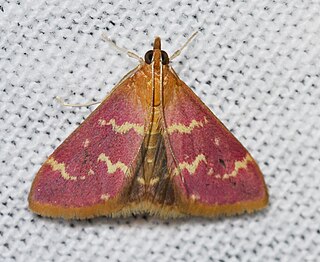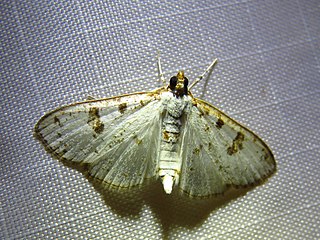Langessa is a genus of moths of the family Crambidae. It contains only one species, Langessa nomophilalis, the black langessa moth, which is found in North America, where it has been recorded from Alabama, Florida and South Carolina.

Parapoynx allionealis, the watermilfoil leafcutter moth, is a moth in the family Crambidae. It was described by Francis Walker in 1859. It is found in North America, where it has been recorded from Alabama, Florida, Georgia, Indiana, Louisiana, Maine, Manitoba, Maryland, Massachusetts, Michigan, Minnesota, Mississippi, New Brunswick, New Hampshire, New Jersey, New York, North Carolina, Nova Scotia, Ohio, Oklahoma, Ontario, Quebec, South Carolina, Tennessee and Texas.
Parapoynx seminealis, the floating-heart waterlily moth, is a moth in the family Crambidae. It was described by Francis Walker in 1859. It is found in North America, where it has been recorded from Florida, Georgia, Massachusetts, Mississippi, New Hampshire, Rhode Island, South Carolina and Texas.

Argyria nummulalis is a moth in the family Crambidae. It was described by Jacob Hübner in 1818. It is found in North America, where it has been recorded from Alabama, Florida, Georgia, Kansas, Maryland, Massachusetts, Mississippi, North Carolina, Pennsylvania and South Carolina.

Crambus laqueatellus, the eastern grass-veneer, is a moth in the family Crambidae. It was described by James Brackenridge Clemens in 1860. It is found in North America, where it has been recorded from Ontario and Maine to South Carolina, west to Texas and north to North Dakota.
Crambus multilinellus, the multinellus grass-veneer, is a moth in the family Crambidae. It was described by Charles H. Fernald in 1887. It is found in North America, where it has been recorded from Florida, Georgia, Illinois, Maryland, Minnesota, Mississippi, North Carolina, Ontario and South Carolina.

Crambus quinquareatus, the large-striped grass-veneer, is a moth in the family Crambidae. It was described by Philipp Christoph Zeller in 1877. It is found in North America, where it has been recorded from Alabama, Florida, Georgia, Louisiana, Maryland, Mississippi, North Carolina, Oklahoma, South Carolina and Texas.

Crambus saltuellus, the pasture grass-veneer, is a moth in the family Crambidae. It was described by Philipp Christoph Zeller in 1863. It is found in North America, where it has been recorded from the north-eastern United States south to North Carolina. It is also present in southern Ontario.

Microcrambus biguttellus, the gold-stripe grass-veneer, is a moth in the family Crambidae. It was described by William Trowbridge Merrifield Forbes in 1920. It is found in North America, where it has been recorded from Alabama, Florida, Georgia, Illinois, Indiana, Kentucky, Maine, Manitoba, Maryland, Massachusetts, Michigan, Minnesota, Mississippi, New Brunswick, New Jersey, New York, North Carolina, Nova Scotia, Ohio, Oklahoma, Ontario, Quebec, South Carolina, Tennessee, Texas, West Virginia and Wisconsin. It has also been recorded from Cuba and Puerto Rico.
Neodactria caliginosellus, the corn root webworm or black grass-veneer, is a moth in the family Crambidae. It was described by James Brackenridge Clemens in 1860. It is found in North America, where it has been recorded from Alabama, Alberta, California, Florida, Georgia, Illinois, Indiana, Maine, Maryland, Mississippi, North Carolina, Ohio, Oklahoma, Ontario, South Carolina and Tennessee. The habitat consists of grassy areas and fields.
Haimbachia placidellus, the peppered haimbachia moth, is a moth in the family Crambidae. It was described by Frank Haimbach in 1907. It is found in North America, where it has been recorded from New York and Massachusetts to South Carolina, west to Tennessee.
Prionapteryx nebulifera, the clouded veneer moth, is a moth in the family Crambidae. It was described by Stephens in 1834. It is found in North America, where it has been recorded from Florida, Georgia, Maryland, Michigan, New Hampshire, Ontario, South Carolina and Wisconsin.

Crocidophora serratissimalis, the angelic crocidophora moth or sawtoothed crocidophora, is a moth in the family Crambidae. It was described by Zeller in 1872. It is found in North America, where it has been recorded from Quebec and New England to South Carolina, west to Manitoba and possibly Texas.

Pyrausta signatalis, the raspberry pyrausta moth, is a moth in the family Crambidae. It was described by Francis Walker in 1866.
Rhectocraspeda periusalis, the eggplant webworm moth, is a moth in the family Crambidae. It was described by Francis Walker in 1859. It is found in the West Indies and from the United States, where it has been recorded from Florida, North Carolina, Ohio, Oklahoma, South Carolina and Tennessee, south through Mexico and Central America to South America, including Ecuador, Brazil, Guyana, Trinidad and Tobago and Suriname.
Donacaula maximellus is a moth in the family Crambidae. It was described by Charles H. Fernald in 1891. It is found in North America, where it has been recorded from Florida, Georgia, Louisiana, Mississippi, Nebraska, North Carolina and South Carolina.
Leucargyra puralis is a moth in the family Crambidae. It was described by George Hampson in 1896. It is found in Brazil.

Herpetogramma abdominalis is a species of moth in the family Crambidae. It was described by Zeller in 1872. It is found in North America, where it has been recorded from Washington state, east to Nova Scotia, and south to Mississippi and North Carolina.

Herpetogramma theseusalis is a species of moth in the family Crambidae. It was described by Francis Walker in 1859. It is found in North America, where it has been recorded from Alabama, Florida, Maine, Maryland, North Carolina, Quebec, South Carolina, Texas and Virginia.

Palpita illibalis, the inkblot palpita moth, is a moth in the family Crambidae. It was described by Jacob Hübner in 1818. It is found in North America, where it has been recorded from Alabama, Florida, Georgia, Maryland, Mississippi, North Carolina, Ohio, Oklahoma, Pennsylvania, South Carolina, Tennessee, Virginia and West Virginia.











